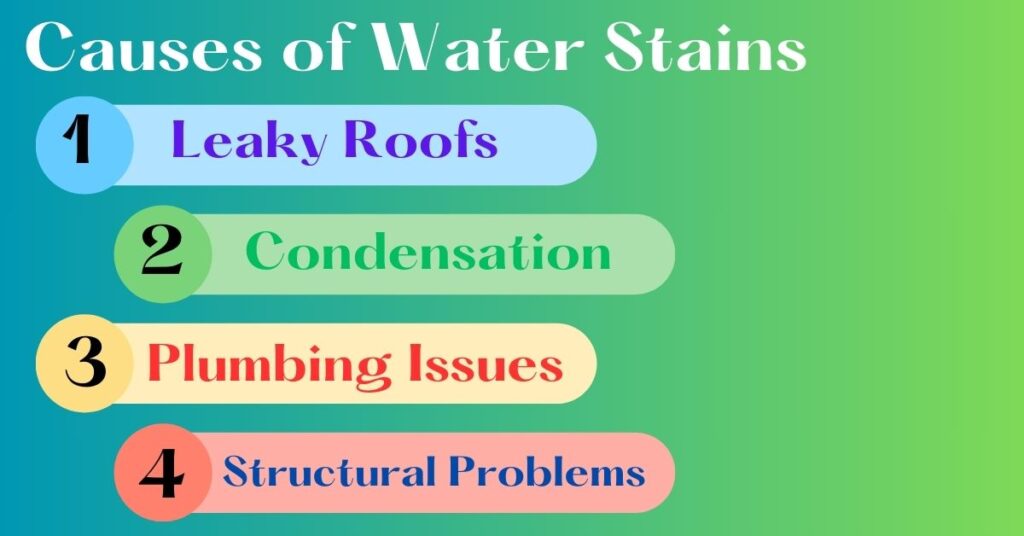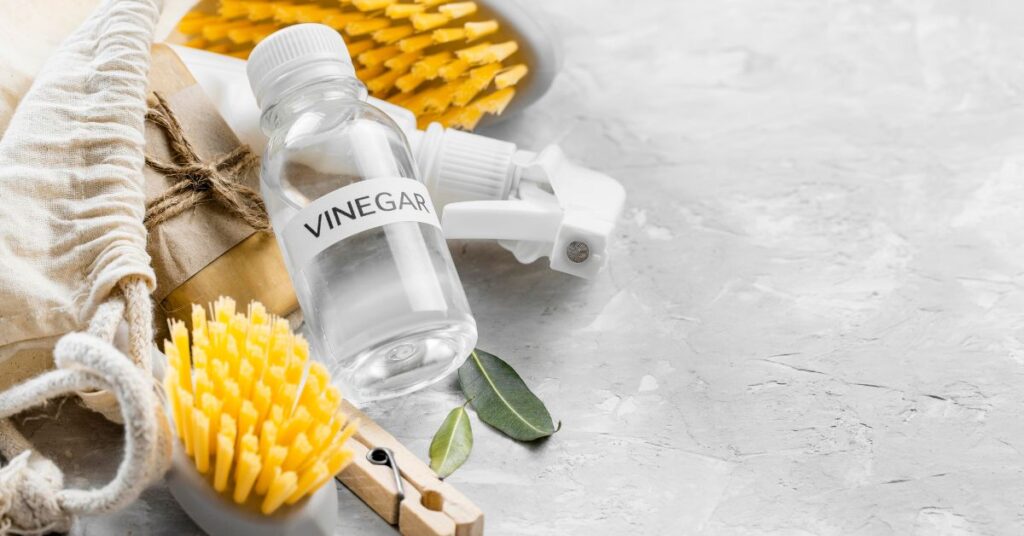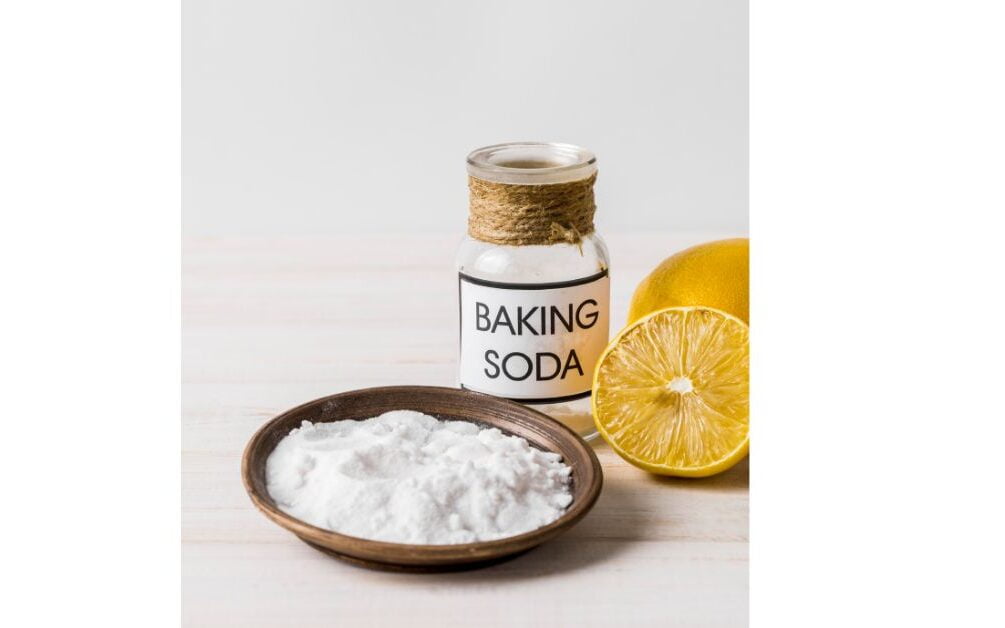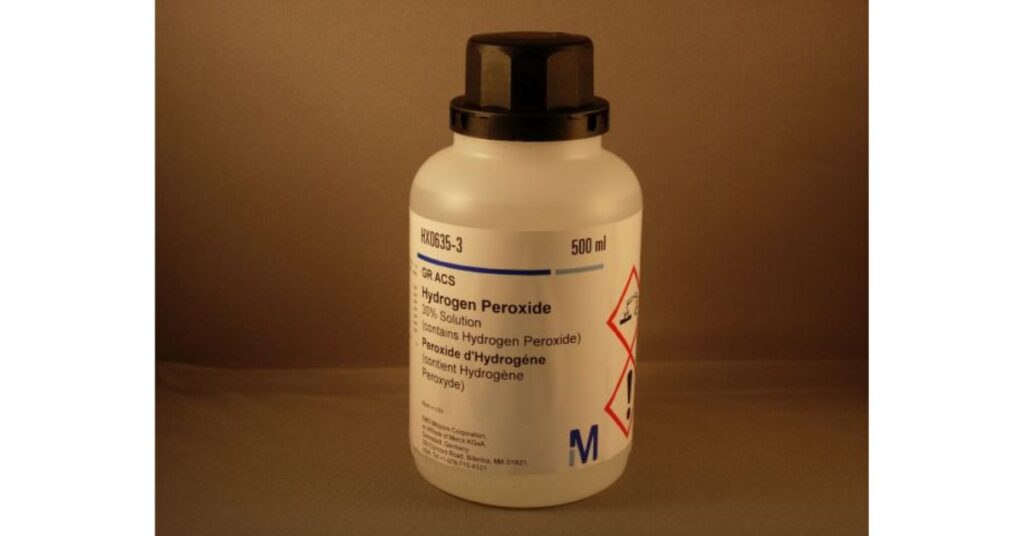Do you have water stains on your ceiling? Remove water stains from the ceiling without having to completely repaint your ceiling.
They not only make your house look less attractive, but they may also be an indication of hidden problems like leaks or inadequate ventilation.
In this blog post, you will get a solution for removing water stains from your ceiling using simple yet effective methods.
Whether it’s the result of a leaky roof, condensation buildup, or other moisture-related factors, we’ve got you covered.
firstly Understand the Causes of Water Stains

Before diving into the methods of stain removal, it’s crucial to understand the root causes of these stains.
Water stains can manifest due to a variety of issues, and identifying the cause is essential for preventing future occurrences.
this stain may occur due to the following reasons:
Leaky Roofs:
A leaky roof is a frequent cause of water stains. Rainwater can enter a building through cracked or missing shingles, openings in the roof, or improperly sealed flashings, causing water infiltration and eventual ceiling staining.
Condensation:
In humid environments, condensation may build up on the ceiling and leave unsightly stains. This frequently occurs in kitchens, bathrooms, and other poorly ventilated spaces.
Plumbing Issues:
Leaky pipes, whether in the kitchen or bathroom, can cause water to drip onto the ceiling. This dripping over time may result in stains that need to be cleaned up.
Structural Problems:
In more extreme situations, structural problems like inadequate insulation or improper sealing can contribute to water stains on the ceiling.
Why Tackling the Root Cause Matters:
Addressing the underlying cause of the problem is just as important as getting rid of the obvious stains.
Recurring stains could result from simply cleaning the stains without addressing the root cause. So, before using stain removal techniques, perform a thorough inspection to find and address the main source of Stains.
Understanding the reason for water stains can assist you in taking the appropriate precautions to stop them from happening again, resulting in a more durable and attractive ceiling.
We’ll walk you through several techniques in the sections that follow so that you can successfully remove water stains from your ceiling without having to repaint it.
These techniques are made to enable you to achieve a stain-free ceiling without the hassle of painting, whether you’re a DIY enthusiast or simply looking to maintain the beauty of your home.
Gathering Necessary Supplies

Before you start the stain removal process, gather the necessary supplies to ensure a smooth and efficient procedure.
Having the right tools and materials at hand will make the process more manageable and help you achieve better results.
Cleaning Agents:
Choose a suitable cleaning solution based on the severity of the stains. White vinegar, hydrogen peroxide, and baking soda are effective options.
Clean Cloths:
Use soft, clean cloths or sponges for applying the cleaning solution and gently scrubbing the stains.
Ladder:
A sturdy ladder will allow you to reach the stains on the ceiling safely.
Protective Gear:
Wear gloves and safety goggles to protect your hands and eyes from the cleaning agents.
With your supplies ready, you’re now prepared to tackle those stubborn water stains using various methods. In the following sections, we’ll guide you through effective techniques to remove water stains from your ceiling, all without the need for a new coat of paint.
Remove water stains from the ceiling
Method 1: Vinegar and Water Solution

Method 2: Baking Soda Paste

Baking soda is a gentle abrasive that can effectively lift stains without causing damage. Creating a baking soda paste enhances its stain-removing capabilities. Follow these steps for stain removal using a baking soda paste:
- Create the Paste: In a small bowl, mix baking soda with water to create a thick paste. The paste should be spreadable but not too runny.
- Prep the Area: As with the vinegar method, place a drop cloth or old towels on the floor beneath the stained area to catch any drips.
- Apply the Paste: Use a clean cloth or sponge to apply the baking soda paste directly onto the stained area. Spread it evenly and let it sit for about 15-20 minutes.
- Gently Scrub: After the paste has had time to work, take a damp cloth or sponge and gently scrub the stained area in a circular motion. The baking soda’s abrasive nature helps lift the stain.
- Rinse and Dry: Dampen another clean cloth with plain water and use it to wipe away any residue from the baking soda paste. Then, pat the area dry with a dry cloth.
- Allow Drying: Similar to the vinegar method, ensure proper room ventilation to facilitate complete drying of the ceiling.
By following these methods, you can effectively remove water stains from your ceiling without the need for painting. However, keep in mind that certain stains may require multiple rounds of treatment for complete removal. Regular maintenance and addressing the root causes of stains will help prevent their recurrence and keep your ceiling looking pristine.
Method 3: Hydrogen Peroxide Solution

Hydrogen peroxide is another powerful option for tackling water stains on your ceiling. Its bleaching properties make it effective in lightening stains. Here’s how to use a hydrogen peroxide solution for stain removal:
- Mix the Solution: In a spray bottle, mix equal parts of hydrogen peroxide and water. Ensure proper ventilation while working with hydrogen peroxide.
- Test an Inconspicuous Area: Just as with the other methods, test the solution on a small, hidden area of the ceiling to ensure it doesn’t cause any unwanted effects.
- Spray and Wait: Spray the hydrogen peroxide solution onto the stained area. Allow it to sit for about 10-15 minutes, giving it time to work on the stain.
- Gentle Scrubbing: After the waiting period, gently scrub the stained area using a soft cloth or sponge. The goal is to lift the stain without damaging the ceiling surface.
- Rinse and Dry: Wipe away the solution residue using a cloth dampened with water. Then, pat the area dry with a clean, dry cloth.
- Final Touches: As always, ensure adequate ventilation in the room to aid in drying the ceiling.
Remember, whichever method you choose, patience and care are key. Stubborn stains may require multiple applications before they’re completely removed. Additionally, preventive measures are essential to ensure that the stains don’t come back. In the next section, we’ll explore the use of commercial stain removers and how to implement preventive strategies effectively.
Method 4: Commercial Stain Removers:
Commercial stain removers offer a convenient and effective solution for removing water stains from your ceiling. These products are specially formulated to tackle various types of stains without damaging the ceiling surface. Here’s how to use them:
- Select a Suitable Product: Visit your local hardware or home improvement store to choose a commercial stain remover. Read the labels and product descriptions to ensure you select a product that’s appropriate for your type of ceiling.
- Prep the Area: Before applying the stain remover, place drop cloths or towels on the floor to catch any drips or spills.
- Follow Manufacturer Instructions: Carefully read and follow the manufacturer’s instructions on how to use the product. Different stain removers may have varying application methods.
- Apply and Wait: Apply the stain remover according to the instructions. Typically, you’ll need to apply it directly onto the stained area and let it sit for a specified period.
- Gentle Scrubbing: After the waiting period, gently scrub the stained area using a soft cloth or sponge. Follow any scrubbing guidelines provided by the manufacturer.
- Rinse and Dry: Use a damp cloth to wipe away the residue of the stain remover. Then, pat the area dry with a clean cloth.
- Ventilate the Room: Allow the ceiling to dry completely by ensuring proper room ventilation.
Commercial stain removers can be a convenient solution, especially for stubborn or persistent stains. However, always prioritize safety by following the manufacturer’s instructions and taking precautions while using these products.
Preventive Measures to Avoid Future Stains:
While these stain removal methods can help restore the beauty of your ceiling, taking preventive measures is crucial to prevent future staining. Here are some effective strategies to avoid water stains in the first place:
- Promptly Fix Leaks: As mentioned earlier, addressing the root cause is vital. If you discover a leak in your roof or plumbing, address it promptly to prevent further staining.
- Improve Ventilation: Proper ventilation is key to preventing condensation-related stains. Install exhaust fans in bathrooms and kitchens, and ensure that your home has adequate ventilation.
- Use Dehumidifiers: In areas with high humidity, using a dehumidifier can help regulate moisture levels and reduce the likelihood of stains.
- Inspect and Maintain: Regularly inspect your roof, plumbing, and insulation for any signs of leaks or weaknesses. Addressing these issues early on can prevent staining and more extensive damage.
- Waterproofing: In areas prone to water exposure, consider using waterproof paints or coatings to add an extra layer of protection.
- Avoid Overwatering Plants: If you have indoor plants, be cautious not to overwater them, as excess moisture can contribute to staining.
Conclusion:
Removing water stains from your ceiling without the need for painting is indeed achievable. Whether you opt for natural solutions like vinegar and baking soda or utilize the power of commercial stain removers, the methods outlined in this blog post can help you restore your ceiling’s pristine appearance.
Regular maintenance, addressing leaks promptly, and maintaining proper ventilation are all part of the equation to keep your ceiling stain-free for the long haul.
FAQ
Can I use household items to remove water stains from the ceiling?
Yes, vinegar, bleach, and baking soda solutions are effective for stain removal.
Is baking soda effective for removing water stains?
Yes, make a paste with water and baking soda, apply to the stain, let it sit, then wipe clean.
Will these methods damage my ceiling?
Properly diluted solutions and gentle application should not damage the ceiling.
How do I apply vinegar or bleach to remove stains?
Mix equal parts of water and vinegar or bleach, apply gently with a sponge or cloth, then rinse.
